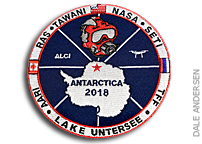Astrobiologist Dale Andersen Antarctic Status Report 19 November 2018: Making Up For Lost Time

“Sorry for taking so long to get back to you, we have just been busy trying to make up for lost time due to the previous storm and taking advantage of the relatively nice weather we have had lately.”
“For the most part the winds the last few days have been very manageable although a couple of nights ago we were hitting 45 knots and gusting to 50 – this time the forecast accurately predicted these winds and our tents easily handled that night’s weather – unlike the previous storm, we simply had a noisy night with little sleep.
Having drilled holes through the ice of the two main basins of the lake we now have access for sampling and collecting water column profiles with various scientific instruments we have with us. Yesterday I profiled the deepest part of the lake (161m) and today we spent most of the day collecting water in that same basin. Tomorrow we will head to the south basin (which is 100 m deep) repeating the same tasks there.
We are also interested in the ice-cover and at each hole drilled we determine it’s thickness. At Lake Untersee ice thickness can vary from about 2.5 m to 4 m across the lake; the variation being due to winds that buffet the lake unequally during the year.
We have many tasks to complete above the ice, but I am still hopeful that we will start working below the ice soon too. My diving compressor was stored inside a large wooden crate during the storm that took out most of camp, and unfortunately that was one of the crates the winds rolled and tossed (despite being 150 kg) dropping it 10-15 m from where we had placed it. Fortunately the compressor survived the unexpected flight across the ice and it started up after warming it in my tent for a couple of days. However, the melter used to create the dive holes refused to ignite and we were unable to make a field repair.
A Twin Otter was sent to our camp by ALCI and the melter was returned to the ice runway facility at Novolazarevskaya. It has since been repaired, now we just need to get it sent back out pending good flight conditions. Once we have the hole melter with us we will make a dive hole and begin our diving operations beneath the ice. The melter will also be used to help retrieve scientific sensors and sampling devices that were deployed last year.
All for now, back in a couple of days with another update.
Cheers, Dale”









